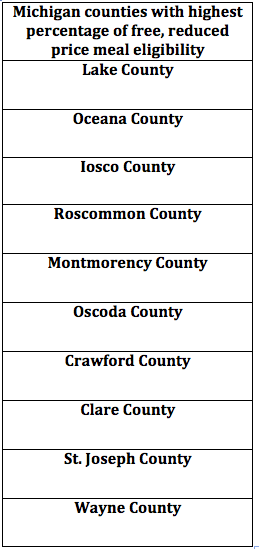By CELESTE BOTT
Capital News Service
LANSING – Almost half the state’s public school students were eligible for free or reduced price meals during the 2011-12 school year, according to a report by Kids Count in Michigan.
Forty-eight percent of students participate in the free or reduced price lunch program, according to the report, “Health Matters.”
Kids Count is a project that advocates for the health and wellbeing of children. The Michigan League for Public Policy and Michigan’s Children are the project’s partners.
The percentage receiving free or reduced lunches increased 2 percent from the 2010-11 school year.
Those involved in the project attribute the high, rising percentage to poverty in the state.
Students from households with incomes at or below 130 percent of the poverty level –an income of $29,965 or less per year for a family of four – qualify for free lunch.
Reduced price lunch eligibility is for students from households with income between 130 percent and 185 percent of the poverty level, up to $40,793 for a family of four.
Wayne, Macomb, Oakland, Genesee and Kent counties had the highest number of participants, but according to Jane Zehnder-Merrell, director of Kids Count, the numbers reflect a statewide problem. Most of the counties with the highest proportion of eligible children are rural.

“The findings show that children across Michigan are still suffering the fallout from our long recession,” Zehnder-Merrell said. “Poverty in Michigan is as big a threat to our children today as polio was to a previous generation.
“Fortunately, we can do something about this. We know that public policy can improve children’s social and economic environment,” she said.
According to the league, the steadily increasing number can be attributed to a number of factors, including the reduction of the Earned Income Tax Credit, stricter limits on cash and food assistance, and reducing the maximum unemployment benefits from 26 to 20 weeks.
“The impact of high unemployment and declining wages is leaving its mark on a generation of children,” Zehnder-Merrell said. “Unfortunately, policymakers have cut family supports aimed at blunting the impact of the economic downturn on kids.”
In an effort to help communities with the greatest financial need, the U.S. Department of Agriculture created a four-year pilot Community Eligibility Program.
Michigan is one of three states participating in the pilot. School districts in Michigan can take part if at least 40 percent of their students are entitled to free meals.
Community eligibility has also been available in Illinois and Kentucky since the start of the 2011‐2012 school year.
Grand Rapids School District is a participant, and this school year, every child in the Grand Rapids public school system is provided a nutritious lunch and breakfast free of charge.
Paul Baumgartner, director of nutrition services for the district, said that in addition to providing financial relief, guaranteed meals have academic benefits.
“This pilot acknowledges the important role school meals make in supporting academic achievement,” Baumgartner said. “We know that academic performance is tied directly to students being prepared, mentally and physically.
“Breaking down the last remaining barriers to accessing healthy and nutritious breakfast and lunch at school will allow every student in GRPS to fuel their body for a more productive day of learning,” he said.
Steps are being taken to ensure that children from households with incomes at or below the poverty level are well-fed in the summer as well.
The Department of Education is looking for more community sponsors to run summer food programs.
Last year, of the more than 575,000 low-income Michigan children who were eligible, only about 85,000 – 15 percent – received free meals or snacks at approved summer meal sites in their neighborhoods.
Michael Flanagan, state superintendent of public instruction, called on schools, churches, local governments and civic organizations to step up.
“There is a desperate need and the food is available,” Flanagan said. “We just need more locations around the state to serve the children.”
Spartan Newsroom - News and information from student journalists at the Michigan State University School of Journalism
Spartan Newsroom (https://news.jrn.msu.edu/2013/02/more-children-eligible-for-free-reduced-price-lunches/)